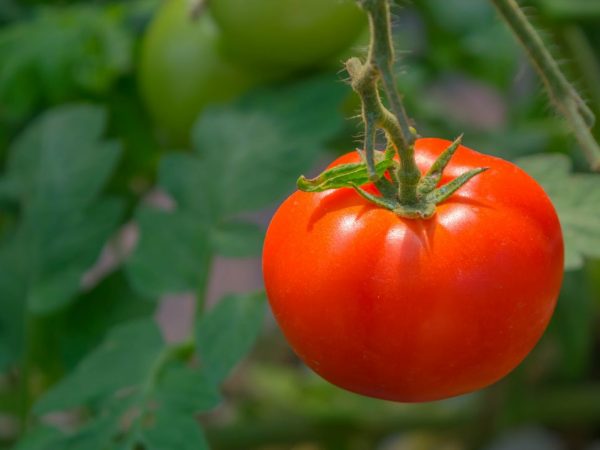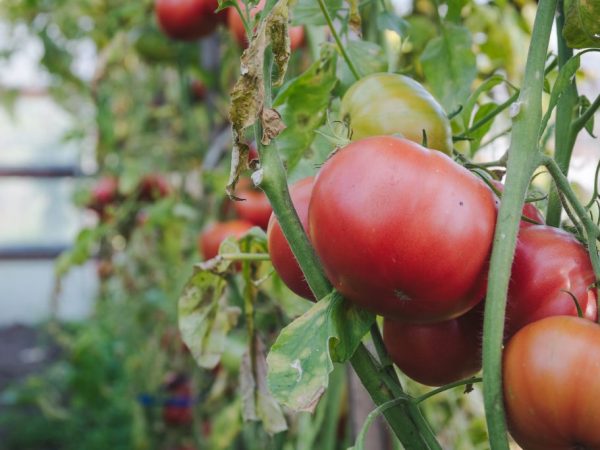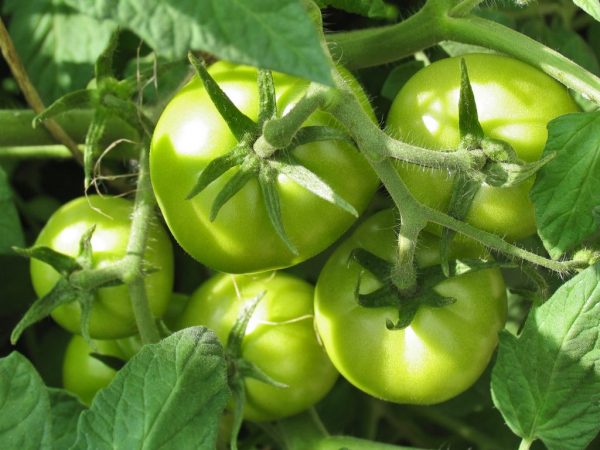Characteristics of a tomato variety Fat
Growing vegetables in the middle zone of the country and Siberia can sometimes be problematic. This is due to the harsh climatic conditions, with the inability to cultivate greens, cucumbers or tomatoes in the open field. But the golden rule of life says that those who do not want to decide something are looking for reasons, and those who want to change something are looking for opportunities for this. So everything happens with everyone's favorite vegetables - tomatoes. There are varieties adapted to growing in unfavorable conditions, and one of them is the Tolstushka tomato.

Characteristics of a tomato variety Fat
Variety characteristic
The Tolstushka variety belongs to the indeterminate species. Its characteristics are, in general, similar to all plants of this type.
- This is a tall hybrid, its height in closed ground can reach 2.5 - 3 m.
- The variety is considered early, when the fruit ripens.
- It is grown in 2 stems, while the yield of tomatoes will be higher.
- Green fruits, collected at the stage of staining, are capable of ripening.
- The Fat Tomato is suitable for all types of consumption.
- The plant is resistant to viruses and diseases inherent in nightshade crops.
Not everyone has greenhouses of great height, so each gardener chooses his own way of growing and limiting the growth of tomatoes.
The best predecessors for tomatoes would be crops such as:
- radish;
- cabbage;
- legumes;
- turnip.
They do not drain the soil when grown. And legumes are able to accumulate nitrogen in the area of \ u200b \ u200bthe roots, which is necessary for the growth of all plants.
Description of the bush
The stalks of the fat woman are strong, but, under the weight of the ripening crop, they can break if they are not fixed on the trellis in time. Wooden supports can also be used. The stems are not pubescent, they have many internodes, in the area of which leaves and flower brushes are formed.
The variety does not produce very many leaves and they are not large. Outdoors, the leaves are dark green, and indoors, they are brighter and grow slightly larger. The veins are poorly expressed; therefore, the leaf blade is slightly embossed.
At the level of 9 leaves, brushes begin to form. Each of them bears about 8 simple flowers. After pollination, the fruits are tied.
Fruit characteristics
According to the characteristics of tomatoes and based on the reviews of gardeners, we can assume that the fruits are universal.
- They can be harvested at the stage of incomplete color of the fruit and can be put on ripening.
- The shape of the fatty fruit is round, slightly ribbed, with a dent in the area of the stalk.
- The skin of tomatoes is dense, so they can be transported for sale over long distances.
- Ripe fruits are suitable for processing and fresh consumption.
Tomatoes ripen 90 days after germination. But the peak, when yields are most plentiful, occurs between 115 and 130 days. Each tomato weighs about 250g when first picked. The next fruits are slightly smaller, weighing about 180g.

Fruits in the bunch ripen almost simultaneously
Round tomatoes are not evenly colored. In the area of the stalk, a darker spot can be observed. And the whole fruit is covered with light stripes. When fully ripe, both the spot and stripes disappear, the fruit becomes a bright red color.
The fruits in each cluster ripen almost at the same time, so they can be harvested once a week. At the same time, their collection, with milky ripeness, will enable the plant to lay new brushes without depleting. Thanks to their firm and firm skin, tomatoes can be stored for a long time.
The taste of tomatoes has a rich tomato, in which you can feel sugariness, with hints of sourness. The pulp, when broken, is as if covered with crystals. It has about 4 seed chambers, but few seeds are formed.
Eating tomatoes
The sweet taste and pleasant aroma of the pulp make it possible for different types of tomato consumption.
- They work well in salads.
- Good yield of tomatoes and the ability to persist for a long time, allows you to make long-term harvesting of fresh fruits.
- Delicious juices taste delicious, with a large admixture of pulp.
- Ketchup, adjika and sauces, they can also be prepared for the winter.
- For conservation as a whole, the fruits of the second ripening wave are suitable - they are smaller than the first.
Colorful and delicious salads will appeal to everyone, even gourmets.
You can also garnish other dishes such as pizzas, kebabs, or potato casseroles with tomato slices and herbs. Bell peppers, spices and herbs can be added to adjikas, ketchups, sauces and other semi-finished products.
Growing seedlings
Almost all varieties of tomatoes are grown by seedlings. Our Fatty is a hybrid, so every year you need to purchase her seeds. Collected independently, they will not give, when grown, those characteristics and features that are inherent in this variety.
Until the time when the finished seedlings need to be planted in a permanent place, at least 60 days should pass. This means that in March you need to prepare containers - nurseries, soil and seeds.
The description of the maximum fertile soil for nightshades says that the soil should consist of several components:
- garden land 70%;
- peat 10%;
- rotted mullein 10%;
- sand 5%;
- sawdust 5%.
Drainage is poured into the container, then the soil and seeds are spread on it, previously soaked in growth stimulants for 8 hours, and washed. A layer of earth about 1 cm is added on top, leveled and sprayed with water from a spray bottle.
The containers are covered with transparent film or glass and placed in a bright place. The temperature during the daytime should be no higher than 25 ° C, and at night around 18 ° C. As the topsoil dries, the soil should be sprayed with warm water.
Seedling care

Only with proper care will the plant delight you with the harvest.
Care comes down to the fact that you need to observe the temperature regime. Lighting, if there is not enough natural light, must be turned on additionally. In the second leaf stage, the seedlings are dived and the containers are opened. Before planting in open ground, it is hardened for 2 weeks, exposing it to the sun for a short time.
Planting tomatoes in the ground Fatty
When planting in greenhouses or open ground, mark the holes so that there are no more than 4 plants per 1m². Supports are installed near the holes, and the holes are spilled with water. Seedlings are planted and, if necessary, tied up.
Tomato care
When planting tomatoes, you need to be ready to carry out measures for the care and protection of plants.
- A mandatory procedure is weeding row spacings and loosening the soil.
- It is necessary to water the plants abundantly once a week.
- You need to fertilize about 3 times during the growing season.
- To carry out prevention against viruses and diseases.
Weeding should not be late so that the weeds do not interfere with the tomatoes, and loosening helps air access to the roots.
You can fertilize tomatoes with microelements and chemicals. Organics such as bird droppings, mullein and a mixture of green herbs also give a good effect. The first treatment is carried out before the ovaries are formed. The next time you can fertilize not earlier than after 10 days from the first feeding.
Disease and insect control
The description of the variety of these nightshades advises to carry out preventive treatment of plants in advance. For this, drugs Aktara, Bravo and other substances are suitable. Onion and garlic tinctures can protect against viruses and small insects. For 1 liter of water, take 100 g of crushed product and insist for about a day. The finished tincture is filtered and diluted with water 1:10. The plantings are sprayed with the prepared solution.
Conclusion
To grow tomatoes in the middle zone of the country, you need to make efforts to create favorable conditions for them. Tomato Fatty will allow you to get a rich harvest of clean, environmentally friendly fruits and put fresh vegetables or preparations made with your own hands on the table. By consuming products, you will be able to give them the best reviews and recommend to your friends, to do interesting and rewarding work such as growing tomatoes on your site.


